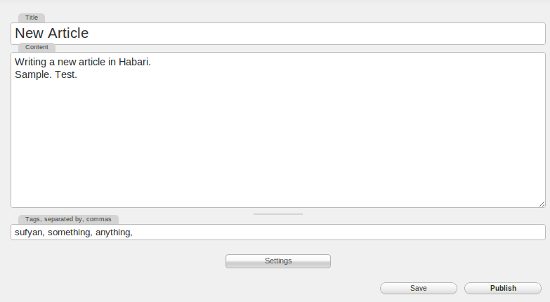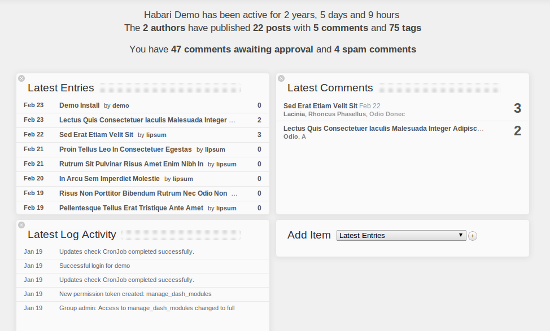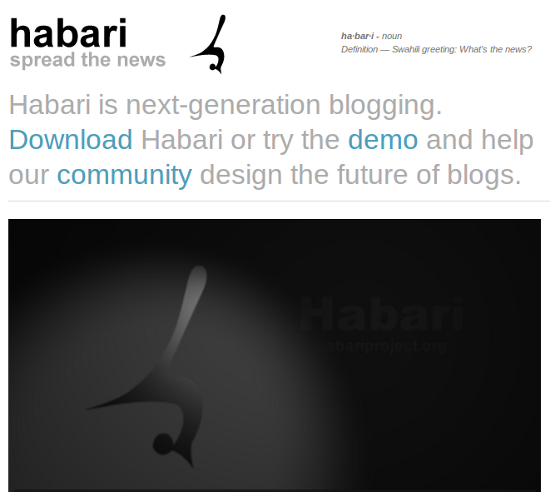Habari – Minimal CMS For More Than Light-Weight Blogging
Here at Noupe, we evaluate content management systems frequently. Having covered MODX, Concrete5 and Joomla! just recently, we will now share a deeper look into Habari. Unlike previous CMSs covered at Noupe, Habari is a bloggers’ CMS -- in the purest sense of the term. While it is true that you can use any CMS to create various types of websites, there should be no argument that Habari is, at least foremost, a tool meant for blogs. Considering the fact that I have mentioned the term ‘blogs’, there are good chances that you might be thinking of WordPress already. Yes, since Habari is a blogging CMS, its comparison with WP is inevitable. We will cover that aspect and lots of others in the following article. So, read on...
 Habari by Rich Bowen shared under Creative Commons Attribution 2.0 Generic (CC BY 2.0) license
As always, this article will bypass topics such as installation procedure and customization guidelines -- you can find such info in Habari documentation. Instead, our focus shall be to assess the usability of Habari as a Content Management System.
Habari by Rich Bowen shared under Creative Commons Attribution 2.0 Generic (CC BY 2.0) license
As always, this article will bypass topics such as installation procedure and customization guidelines -- you can find such info in Habari documentation. Instead, our focus shall be to assess the usability of Habari as a Content Management System.
 Article Editor in Habari[/caption]
For instance, let us take up the simple task of publishing a new blog post. You will find a self-explanatory command to
Article Editor in Habari[/caption]
For instance, let us take up the simple task of publishing a new blog post. You will find a self-explanatory command to  Dashboard in Habari Admin Panel[/caption]
Another downside to Habari lies in the practical side of things. On the theoretical side, Habari surely is flexible. You can create photo blogs, video blogs, news websites, possibly even e-Commerce sites using it. However, when it comes to the practical affair of things, the story is different. If you are creating an e-Commerce website, you will probably opt for a CMS that has special features for you -- maybe even extra plugins. Even though you might be aware that Habari can work for you if tweaked sufficiently well, you will opt for the other CMS that offers a more ready-made solution. This is a valid choice as this method will save your time which you would’ve otherwise spent in customizing Habari.
Dashboard in Habari Admin Panel[/caption]
Another downside to Habari lies in the practical side of things. On the theoretical side, Habari surely is flexible. You can create photo blogs, video blogs, news websites, possibly even e-Commerce sites using it. However, when it comes to the practical affair of things, the story is different. If you are creating an e-Commerce website, you will probably opt for a CMS that has special features for you -- maybe even extra plugins. Even though you might be aware that Habari can work for you if tweaked sufficiently well, you will opt for the other CMS that offers a more ready-made solution. This is a valid choice as this method will save your time which you would’ve otherwise spent in customizing Habari.
 Yes, the Habari community is passionate enough to customize the layout of their websites manually, but if Habari is to win new converts, it will have to target the section of end users as well -- and ‘end users’ need ready-made templates, period.
That said, Habari’s plugin repository, on the other hand, is wonderful. You will find virtually everything that might be needed for a blog: Feedburner integration, anti-spam, Flickr and Twitter integration, Disqus comments, and so on. This shows that neither the community nor the devs are lacking in talent.
Yes, the Habari community is passionate enough to customize the layout of their websites manually, but if Habari is to win new converts, it will have to target the section of end users as well -- and ‘end users’ need ready-made templates, period.
That said, Habari’s plugin repository, on the other hand, is wonderful. You will find virtually everything that might be needed for a blog: Feedburner integration, anti-spam, Flickr and Twitter integration, Disqus comments, and so on. This shows that neither the community nor the devs are lacking in talent.
 Habari by Rich Bowen shared under Creative Commons Attribution 2.0 Generic (CC BY 2.0) license
As always, this article will bypass topics such as installation procedure and customization guidelines -- you can find such info in Habari documentation. Instead, our focus shall be to assess the usability of Habari as a Content Management System.
Habari by Rich Bowen shared under Creative Commons Attribution 2.0 Generic (CC BY 2.0) license
As always, this article will bypass topics such as installation procedure and customization guidelines -- you can find such info in Habari documentation. Instead, our focus shall be to assess the usability of Habari as a Content Management System.
Habari -- A Bloggers' CMS
1. Usability (Ease of Use)
Note: Just in case you haven’t ever tried it, you can check out a working demo of Habari here. If I were to describe the Habari interface in one word, I would most likely opt for ‘usable’. Habari is one of the most user-friendly CMSs that you will ever come across. That said, it must be pointed out that the term ‘usability’ itself is subjective -- what is usable for me may not be usable for you, and vice versa. However, if you were to leave out the subjective elements, such as customization tools, plugins, installation of themes, etc. and focus entirely on the software’s UI, you would almost certainly find Habari to be extremely simple to use. Basically, the key behind Habari’s usability is its minimal approach -- all you have is a simple menu with keyboard shortcuts, and a minimal interface. Trust me, you can never lose your way while using Habari. [caption id="attachment_74631" align="alignnone" width="550"] Article Editor in Habari[/caption]
For instance, let us take up the simple task of publishing a new blog post. You will find a self-explanatory command to
Article Editor in Habari[/caption]
For instance, let us take up the simple task of publishing a new blog post. You will find a self-explanatory command to Create a New Article right in front of you. What else can one ask for?
On the downside, once you find your way to the New Article editor, you might miss the heavily armed TinyMCE toolbar that you are used to seeing in WP. In the end, it will take some level of ‘getting-used-to’.
- Pros: Extremely swift, minimal and nimble interface
- Cons: Not meant for you if minimalism isn’t your cup of tea
2. Flexibility and Customization
Habari is flexible and you can easily customize it to suit your needs. However, it all comes down to what you wish to get out of it: if you are expecting a MODX-like customization experience, you will probably find only disappointment. On the other hand, if you like to get to the edge of things and tweak your CMS to your liking, Habari can do wonders for you. Apparently, as far as I can get it, the pro-customization model adopted by Habari has really not been marketed well. A CMS such as Drupal or MODX can easily boast of being flexible and get away with it -- there is a huge community that is willing to back up the flexibility boast, and if they can back it up, that very boasting becomes a fact. The Habari community is a smaller entity, and naturally the ‘customization examples’ that one might be looking for are less in number. [caption id="attachment_74628" align="alignnone" width="550"] Dashboard in Habari Admin Panel[/caption]
Another downside to Habari lies in the practical side of things. On the theoretical side, Habari surely is flexible. You can create photo blogs, video blogs, news websites, possibly even e-Commerce sites using it. However, when it comes to the practical affair of things, the story is different. If you are creating an e-Commerce website, you will probably opt for a CMS that has special features for you -- maybe even extra plugins. Even though you might be aware that Habari can work for you if tweaked sufficiently well, you will opt for the other CMS that offers a more ready-made solution. This is a valid choice as this method will save your time which you would’ve otherwise spent in customizing Habari.
Dashboard in Habari Admin Panel[/caption]
Another downside to Habari lies in the practical side of things. On the theoretical side, Habari surely is flexible. You can create photo blogs, video blogs, news websites, possibly even e-Commerce sites using it. However, when it comes to the practical affair of things, the story is different. If you are creating an e-Commerce website, you will probably opt for a CMS that has special features for you -- maybe even extra plugins. Even though you might be aware that Habari can work for you if tweaked sufficiently well, you will opt for the other CMS that offers a more ready-made solution. This is a valid choice as this method will save your time which you would’ve otherwise spent in customizing Habari.
- Pros: Flexible CMS; has the potential to power various genres of websites
- Cons: Very few practical examples of customization
3. Community and Documentation (Help and Support)
Habari has a very active and enthusiastic community. If you ever find yourself confused regarding any feature of Habari, just go ahead and ask the users -- in all likelihood, you will find a solution to your problem. In fact, if I may add, I often find the user community for smaller CMSs to be more friendly than that of a bigger CMS, such as WordPress or Drupal. Speaking of documentation, well, it surely can be improved. The user manual and wiki are all updated and quite solid. However, it is the screen casts and other miscellaneous things that need some work -- not in terms of quality, but in terms of quantity. Habari would surely benefit from a higher number of videos and, possibly, some statistics or graphics about its usage. Love it or hate it, the internet today is a nation of pomp and show, and videos and images go a long way in winning new converts.- Pros: Active and helpful community
- Cons: Only text wiki and docs are extensive; screencasts are pretty limited in number
4. Other Miscellaneous Elements
Habari claims that it supports multiple database backends, multiple users, static content (pages), tagging, and has importers for WP and Serendipity. Cool, isn’t it? Actually, it is. But it needs to be more than that. As far as I can get it, having multiple users as well as support for static pages on a blog and tags cannot be called a big deal. Every other CMS supports that (it needs to die if it doesn’t). What Habari currently needs is a good number of themes -- possibly the evolution of a framework (such as Twitter Bootstrap or Hybrid Core for WP), and responsive child themes. With the latest version, a new responsive theme having support for child themes has come into existence, by the way. Yes, the Habari community is passionate enough to customize the layout of their websites manually, but if Habari is to win new converts, it will have to target the section of end users as well -- and ‘end users’ need ready-made templates, period.
That said, Habari’s plugin repository, on the other hand, is wonderful. You will find virtually everything that might be needed for a blog: Feedburner integration, anti-spam, Flickr and Twitter integration, Disqus comments, and so on. This shows that neither the community nor the devs are lacking in talent.
Yes, the Habari community is passionate enough to customize the layout of their websites manually, but if Habari is to win new converts, it will have to target the section of end users as well -- and ‘end users’ need ready-made templates, period.
That said, Habari’s plugin repository, on the other hand, is wonderful. You will find virtually everything that might be needed for a blog: Feedburner integration, anti-spam, Flickr and Twitter integration, Disqus comments, and so on. This shows that neither the community nor the devs are lacking in talent.
- Pros: Good plugin repository
- Cons: Most themes look outdated in appearance

Its worth giving it a try. Will try to test it soon, Thanks!
Does it have SEO features like WordPress. I would give it a try though.